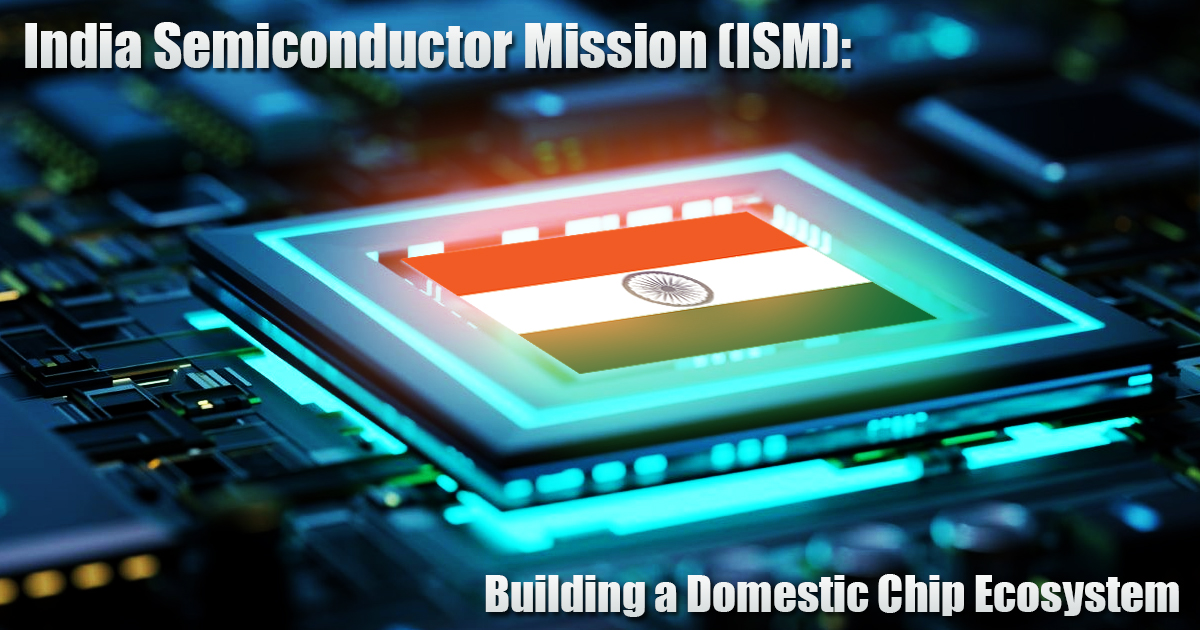
Introduction
The Indian government, recognizing the critical role of semiconductors in the digital age, launched the India Semiconductor Mission (ISM) in 2021.
This initiative aims to address the country’s dependence on foreign chipmakers and foster a robust domestic semiconductor ecosystem
Objectives of the ISM
The ISM has a multi-pronged approach to propel India’s semiconductor industry:
- Developing Semiconductor & Display Manufacturing: The mission aims to establish India as a global leader in semiconductor and display manufacturing. It provides financial and infrastructural support for setting up fabrication facilities (fabs) for both chips and displays.
- Strengthening Semiconductor Design Ecosystem: India boasts a strong design talent pool. The ISM seeks to empower this segment by providing access to Electronic Design Automation (EDA) tools, foundry services, and incubation support for startups.
- Promoting Indigenous IP and Technology Transfer: The mission encourages homegrown innovation by fostering Intellectual Property (IP) generation within India. It also facilitates the transfer of technology (ToT) from established players to bolster domestic capabilities.
- Building a Trusted and Secure Supply Chain: The ISM recognizes the importance of a secure and reliable supply chain for semiconductors. It strives to facilitate the domestic production of raw materials, specialty chemicals, gases, and manufacturing equipment to reduce dependence on external sources.
- Facilitating Skill Development: Building a skilled workforce is crucial for the success of the mission. The ISM works with educational institutions and industry partners to create robust training programs for engineers and technicians in the semiconductor field.
These objectives highlight the mission’s comprehensive approach to nurturing a self-sufficient and globally competitive semiconductor industry in India.
Challenges: A Steep Climb Ahead
Despite its ambitious goals, the ISM faces several challenges:
- High Capital Investment: Setting up semiconductor fabs requires enormous financial resources. Attracting both domestic and foreign investors with attractive incentives and a stable policy environment will be critical.
- Technological Gap: Leading chipmakers possess advanced technologies. Bridging this gap necessitates substantial investments in research and development (R&D) to keep pace with rapid advancements.
- Competition: Established global players dominate the semiconductor market. India needs to create a competitive edge by offering a skilled workforce, cost advantages, and a supportive regulatory framework.
- Talent Pool Development: Building a workforce with specialized skills in chip design, fabrication, and testing requires robust training programs and industry collaboration.
- Intellectual Property Concerns: Protecting indigenous IP creations while attracting foreign investments with technology transfer will be a delicate balancing act.
Provisions: Empowering Growth
The ISM offers various provisions to accelerate India’s semiconductor journey:
- Financial Support: The mission provides financial incentives for setting up fabs and design units. The Scheme for Setting up of Semiconductor Fabs in India offers up to 50% of project costs. Additionally, tax breaks and subsidies are offered to attract investments.
- Infrastructure Development: Building necessary infrastructure, including power grids, special economic zones, and cleanroom facilities, is critical. The ISM aims to facilitate the creation of such infrastructure to support fab operations.
- Research & Development Focus: The mission recognizes the importance of R&D in achieving technological parity. It encourages collaboration between academia and industry to drive innovation in chip design and fabrication processes.
- Promoting Innovation: The ISM provides support for startups and incubators focused on chip design and related technologies. This fosters a culture of innovation and helps bring new ideas to the market.
- Skill Development Initiatives: The mission works with educational institutions and industry partners to create training programs tailored to the specific needs of the semiconductor industry.
A Collective Endeavor
The success of the ISM hinges on a collaborative effort:
- Government: The government needs to continue providing financial and infrastructural support, streamline regulations, and create a stable policy environment conducive to long-term investments.
- Industry: Leading semiconductor companies from India and abroad can play a pivotal role by investing in fabs, collaborating on R&D, and sharing expertise with domestic players.
- Academia: Universities and research institutions need to focus on semiconductor research, develop specialized training programs, and create a talent pool for the industry.
- Skilling & Training: Upskilling and reskilling existing IT professionals and creating new training programs for engineers and technicians are crucial to bridge the skill gap.
By working together, these stakeholders can ensure the realization of the ISM’s vision.
 Chinmaya IAS Academy – Current Affairs Chinmaya IAS Academy – Current Affairs
Chinmaya IAS Academy – Current Affairs Chinmaya IAS Academy – Current Affairs
